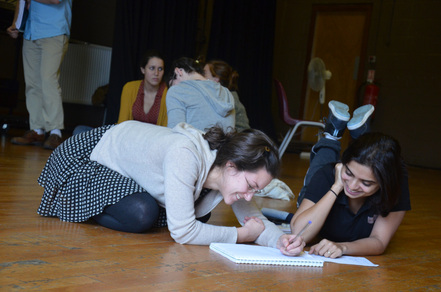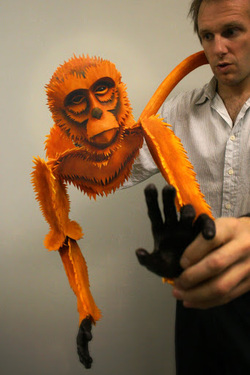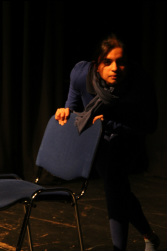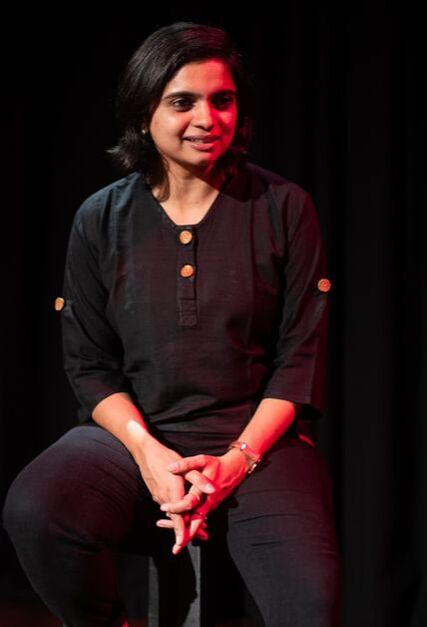 Being a student of Drama is not just about wearing black and learning lines. It’s an attitude - to seek, imbibe and experiment, within ourselves and with what’s around us. There are ideas and stories out there, in every breath and step of ours. We just have to look to find them. Find, capture and embrace them, and before you know, Drama begins. The word Drama comes from the Greek word Dran, which is to do. Looking becomes doing, when done actively. I begin my drama process, by looking and absorbing the environment, the people in it, the space I am in, the objects around me, the sounds I can hear and everything else that I can feel. This is my inspiration to start creating new work. When this is done with a team, you have ideas that you can play with, develop and craft. This is the beginning of collaborative working. Royal Central School of Speech and Drama is one of the oldest drama schools in London, started in 1906. Its special strength, unique in the sector, lies in a combination of first-rate practical training and production, with a highly ranked programme of research - research aimed at the cutting edge of new performance practice. Affiliated to the University of London, Central School offers dedicated drama programmes in the field of Advanced Theatre Practice, Movement Studies, Voice Studies, Applied Theatre, Acting, Actor Training Scenography, Creative Producing , Writing and Performance based research. Studying drama is focused on process as opposed to outcomes. We are given guidelines as opposed to instructions. We are encouraged to build and shape our ideas, given that there is no such thing as a bad idea. Professors are practitioners who continue to create and devise work across the world, thereby constantly widening the scope of learning through doing. Studying with collaborators from various cultures pushes you to think afresh, and do what’s different. On the course, we currently have Circus Acrobats, Opera Singers, Ballet Dancers, Lighting Designers, Art Critics, Playwrights, Directors, Actors, Stand-up comedians and Marketing Professionals as students. This environment opens up possibilities and helps us push boundaries. In doing so, new work emerges. Studying in London is a great opportunity to watch a variety of drama, from classics to west end musicals to performance art. There are shows in which we are passive spectators to plays in which we become active participants. There are classical performances that take you to another world and there are immersive fringe shows that involve you in a new reality. This plays a part in shaping our understanding about possibilities in Drama, with drama. Through the course, we also have the opportunity to interact with artists making these shows. This gives us an understanding of working methodologies and development processes used by specific companies to devise and develop work. Apart from drama practitioners, we also get to interact with Puppeteers, designers and artists who collaborate to create inter-disciplinary work. Through the year, students are encouraged to collaborate with other courses to enhance work content, style and design. The school comes equipped with Auditoriums, Drama Studios, Lighting and sound booths, Costume design and execution labs, set construction garages and other digital equipment that may be needed for performance. In short, the school is fully equipped in terms of drama related infrastructure. An entire theatre and allied art focussed library offers dedicated books, journals and other material that contributes to widening our areas of learning. The school offers under graduate and post graduate programmes with both full time and part time possibilities. The course begins in September-October every year and applications open in January. The admission process happens in two stages, starting with a written application, followed by a creative audition. The school also has the option of conducting auditions over video for International students. In this digital age, we can access information virtually by just exercising our fingertips. So what makes drama different? Drama is not information. It's an experience. Drama is not about place. It's about space and shaping it, using your body, imagination and time. Drama is live and alive. It is about that moment. It is that medium when repeated or recreated, changes. It is about you, what you believe in, what you can change and what you can create. It can transport you, move you, mould you, shake you up or show you what’s really real. That’s the power of drama. Let's live it. This article was published in The Hindu, Education Plus. To read it, click here
0 Comments
 There are objects all around us. Some to use, some to look at, some to be with, some to take help from and some to give away. From furniture to utensils, toys to artifacts, clocks to mobile devices, clothes to shoes to hats and more - Objects complete us in multiple ways. We invest time, energy and money using the many objects we do. Objects come into our lives, serve their duties and disappear. How would it be if these lifeless objects that are so intrinsic to over lives come alive? "The only rule in puppetry is to bring to life inanimate objects" (Francis in Ganesh Ram: 11.11.2012). The thought of possessing the power to 'bring to life' is fascinating. The magic of making anything and everything speak, move, walk and talk seems like a bestowed boon of sorts, waiting to be explored and experimented with. Mark Down, Puppeteer from Blind Summit, focuses on breath and its importance in completing the illusion for audiences through puppetry. Breath and bringing to life go hand in hand. Neither can exist without the other. Though they complement each other, they are essentially one. "'Breath is the engine of all emotion"(Down, 2012). All living things; plants, animals and humans breathe. They breathe to exist and to serve a purpose. A purpose that ensures the status quo. Though breathing is involuntary, it can be controlled. A controlled breath has the power to bring to life objects that can therefore influence. This brings alive characters, plots, stories and situations that transport us into another world, shaping our imagination and creating unique experiences using space, form, rhythm and time. That is what puppetry can deliver. An experience that uses the audience's imagination to construct a new reality. Down also explains that Puppets coming to life is based on four distinct breath oriented functions. "Inhale. Suspend. Exhale. Suspend. Most action occurs on the suspended in-breath, or if you prefer in the controlled exhale: speaking, signalling, starting to walk. The in-breath is literally the inspiration for action, or the intention. The exhale acts as brakes for the movement, and the suspended out-breath is when we assess the action and the results. When the breath pauses, the action is suspended. The scene pauses, but it does not stop."(Down, 2011) The Hindu Yogi science of breath qualifies life as a series of breaths. A toddler inhales the very first life inducing breath and releases it in an long wail while life ends for the aged in an faint gasp, when they cease to breathe. Life and death are both an action and function of breath. Adrian Kohler of Handspring Puppetry relates this aspect to acting, puppetry and theatre. "An actor struggles to die onstage, but a puppet has to struggle to live. And in a way that’s a metaphor for life." (Kohler, 2011) According to Penny Francis, 'The term puppetry denotes the act of bringing to imagined life inert figures and forms (representational or abstract) for a ritual or theatrical purpose - for a performance'. (Francis, 2012: 5). To enable that imagination successfully, an audience have to see, hear and feel a puppet breathe, move, communicate and therefore live. This life is bestowed on a puppet by its operator, the puppeteer. The puppeteer is truly the mother of a puppet, feeding it and nourishing it to stay alive. ''The puppet is an entity which absorbs its operator's energy and is thereby able to convince the spectator of its vitality. It is a matter of transferred, not duplicated kinesthetics. If the puppeteer is projected 'into' the puppet character, it cannot but be the cynosure, it cannot make a wrong gesture; it cannot produce the wrong voice.''(Francis, 2012:28) In the case of 'hands on' or 'hands in' puppetry, a medium where the puppeteer is in contact with the puppet's body in some form or the other, the puppeteer is breathing with different parts of his body to enable life in the puppet and make this life visible to audiences. Nikki Tilroe terms this as 'Muscle respiration' and it being a critical technique to create an illusion of life in a puppet. (Tilroe, 1988: 18-19) Based on the puppet, its form, size, shape and desired attitude, the puppeteer alters his breathing speeds, rhythm, size and form to communicate the story and create the illusion of life, motivating the audience to suspend their disbelief. Basil Jones, co-founder of handspring puppet company believes that breath is a crucial indication of the puppet's life on stage. " The audience can see and feel you breathing and therefore see the puppet living. The rhythm and the a-rhythm of the breath and the way it changes is a very important emotional indicator as to the thoughts and the feeling of the puppet being manipulated." (Jones, 2011) Jacques Lecoq believed that every emotion can be achieved with a push or a pull action. "I push or I pull. I push or pull myself. I am pushed or pulled."(Lecoq, 2006: 22) Breathing functions similarly. A push or a pull in breathing can communicate different emotional responses. Rhythm in the simultaneous push & pull of breath is central to perceiving the state of the puppet. "Shock and surprise for instance are achieved by the inhale action at different speeds."(Tilroe, 1988: 19) The emotions pain and exhaustion can be achieved through an exhale of the breath. Emotions such as joy and sorrow can be achieved with both inhale & exhale. However, the way a puppet moves in relation to the breath is also important in fulfilling the desired illusion. A puppet would mostly move backward to portray shock and move forward for exhaustion, while it could move back and forth for joy. In bringing a puppet to life, the role of the puppeteer and the relationship with the puppet is vital in making effective performance. Tadeusz Kantor, a visionary Polish theatre-maker and designer propagated that "There must be a very close, almost biological symbiosis between an actor and an object. They cannot be separated. In the simplest case, the actor must attempt to do everything for the OBJECT to stay visible, in the most radical case the actor and the object must become one." He calls this state a BIO-OBJECT. (Kantor,1993: 240 in Francis, 2012: 20). Francis adds yet another dimension by involving the audience into the equation and introducing a relationship that is shared between the puppet, the puppeteer and the audience. "A delicate triangle of projected energy and response from the puppeteer through the object to the audience has to be formed, but is rarely sustainable for long." (Francis, 2012: 18) This triangle of energy also indicates a shift in focus of the viewer from puppet, to puppeteer to the technique and back to the puppet. "This changing focus is evidence of an alternating belief and un belief in the puppet's autonomous existence. This condition has no scientific label that I can find, but has been described (poetically) as the 'Opalisation effect' (Jurowski, 1988: 41-42) and (confusingly) as 'double vision' (Tillis, 1992: 59). Probably the most accurate word 'oscillation', is used by TA Green and WJ Pepicello (Green, 1983: 157)"(Francis, 2012: 21) To the initiated, the confluence of the puppet, puppeteer and the technique will create the illusion. To the uninitiated, the invisible equation will still facilitate illusion, but they may not be in a position to appreciate the aspects at play. In National Theatre's War Horse by Handspring puppetry, life sized horses are represented using puppets. Three puppeteers, one playing the face and neck of the horse, the other the heart and fore limbs and the third playing the hind limbs and tail, together create the illusion of the horse breathing, moving and reacting to stimuli through the performance. This demands harmonious coordination between the various puppeteers, including breath, movement, rhythm and synchronised reactions that together create the bigger picture for the audience as well as for other members in the performance. Miniscule movements of the horse, the way its body twitches, the up and down action of the body indicative of breath, is clearly visible even from the last rows of the performance auditorium. This is the precision that can be achieved with puppetry. Little did one know that cane and fabric bunched together artistically could come alive as war horses, puppeteered diligently. As a medium, puppetry also offers the unique advantage of portraying situations that are beyond human reach in a performing scenario. Explicit Murder, brutality and other grotesque realities that may be difficult to portray using one's own body, may apply puppetry techniques to show and soften the impact that the performance may render to audience sets. Dancer and performer Dan Hurlin in the context of comparing dance and puppetry says "While Dance pushes the body to its limits, puppetry can explore what lies beyond those limits." (Hurlin in Animated Bodies, 2009: 7) In essence, Breath and therefore breathing is a starting point to almost any form of creative practice that one chooses to undertake. Puppetry uses the operators breath and the object strives to make it its own and therefore comes to life. The human therefore is the technology that the puppet employs to spring to life. As actors or performers, our own breath, its controlled rhythm, size and variation sets our energy levels on stage and outside of it. Apart from contributing to successful artistic creation, breath and its control can be critical starting points in training for personality development, communication skills and voice practices too. Breath is that engine that runs our body, mind and what the combination of body and mind can achieve. What is the difference between being a performer and an actor ?
A performer performs and an actor acts. This would mean the former is a more truthful portaryal of what one feels and what one one believes in. Acting however, is mostly imitation. You create impulse or stimuli that you want to be influenced by and therefore respond to them in a way that you are motivated to. Performance is about honouring your own beliefs and your own stimuli that is predominantly intrinsic. When a musician is creating music with his violin, you dont say “he’s a great actor”, but you say “he’s a good performer” The same would apply to a dancer, a Circus acrobat, a magician and a puppeteer. Over the last 3 months, I have come to realise the power of being a performer over being an actor. Being a performer is more gratifying. It feels good when Aruna plays Aruna on stage as opposed to playing Martha or Bettie or Olivia. Playing creatively with what comes naturally to you is a basic start to making performance. This does not mean that you don’t learn new things. For example, if performers decide to invest in a new skill through training, that becomes a life skill more than just a skill for a particular show. Performers can learn to Juggle or skate, and then their acquired skills are displayed when they’re performing This way, you are not acting like you are skating, because that’s just not possible. I always believed that I was a hopeless actor. However, over the last 3 months, I seem to develop a strange confidence of being a performer, where I play with material that’s mine. Material that i can personally connect with. Material from my own life – Personal Material. This does not mean that we cannot approach adaptations or scripts that already exist. We just have to approach them in a slightly different manner. Focus on what the play means to you as opposed to what it generally means. Creating performance also inspires you to make original work that’s inspired by what you have seen and experienced. A sense of attachment comes through when performers create work that has their personal stamp on it. I am looking forward to create performance that is devised, original and involves personal material, stories and experiences. Let’s see how and where this goes ! |
Archives
March 2020
Categories
All
|

